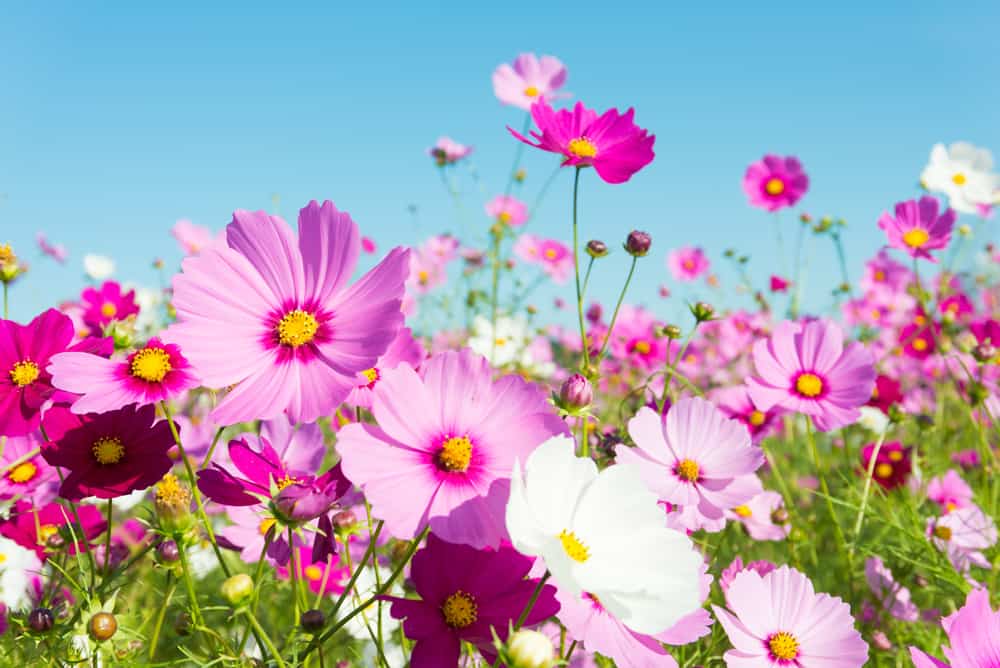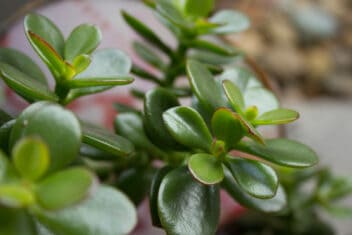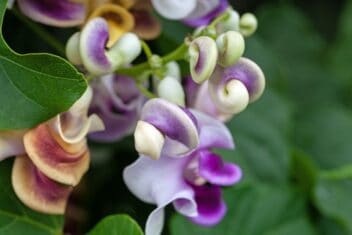When the weather starts to warm up and birds start chirping, spring has arrived. I’s time to think about planting flowers in your garden. Cosmos are the perfect flower to add cheerful, long-lasting color to your space.
Cosmos are easy to maintain, and you fill a large area as a mass-planting option. It only takes a few months for these flowers to bloom from seed, so you can plant spring seeds and have blossoms in time for summer.
The best thing about cosmos, besides their easygoing nature, is that you can find them in a range of beautiful colors. Let’s jump into everything you should know about growing cosmos:
Get to Know Cosmos
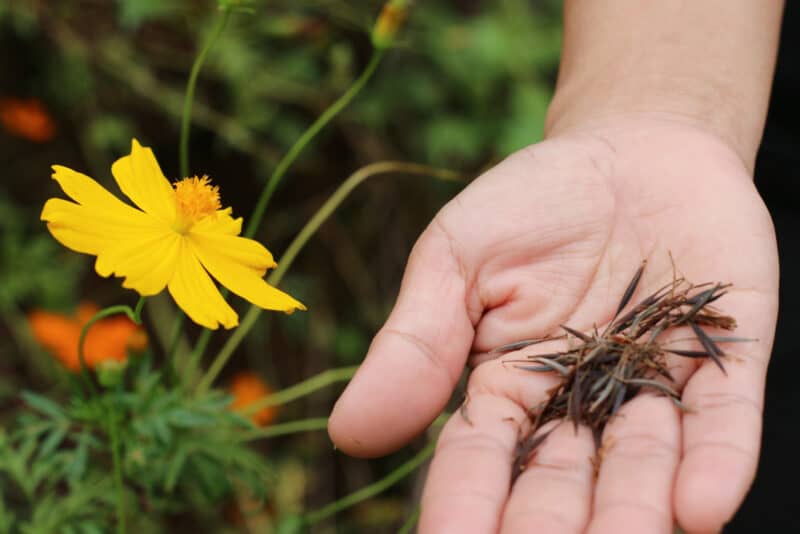
There are over 20 species of cosmos, but only a few are common in gardens. These are Cosmos atrosanguineus, C. bipinnatus, and C. sulphureus.
Garden cosmos (C. bipinnatus) come in mainly white, orange, and light pastel colors like pink and red. Depending on the cultivar, the plant can grow up to six feet tall with large blossoms. These plants can escape the garden and become naturalized in some areas.
Sulfur cosmos (C. sulphureus) is the best species if you live in warm regions. This species can grow in hot climates with little rainfall. It can reach six feet, and blooms in double or semi-double flowers. They bloom in a bright yellow and golden color.
This species is considered invasive in some parts of the southwest.
Chocolate cosmos (C. atrosanguineus) is a unique plant with dark red flowers that smell like chocolate. These are a bit harder to find, but worth the search. They’ll grow about three feet tall.
Since cosmos can grow up to six feet tall, though many are much shorter, they can make quite a statement. Many gardeners place tall types in the back areas of their garden and use the smaller ones to create a border.
Another reason for growing cosmos is that they can grow low to the ground or in raised beds. Cosmos are the perfect choice for people who live in warm climates but want to keep bright flowers on their homestead.
Cosmos grow well as annuals in USDA Hardiness Zones 2-11.
Planting Cosmos

You can succeed with growing cosmos in both containers or directly into the ground. Start seeds indoors in March or April, aiming to start around six weeks before the last frost date. Start seeds outdoors after the last predicted frost date.
Indoors, use seed trays filled with seed starting medium. Outside, amend the soil six inches deep with well-rotted compost.
Place seeds an inch deep and two-three inches apart. Tubers should be twice as deep as their length. Water the soil well. Place pots near a bright, south-facing window or under grow lights for about six hours per day.
For indoor started seeds, wait until the last predicted frost date and harden the seedlings off for a week before planting them in their permanent spot.
Care for Growing Cosmos
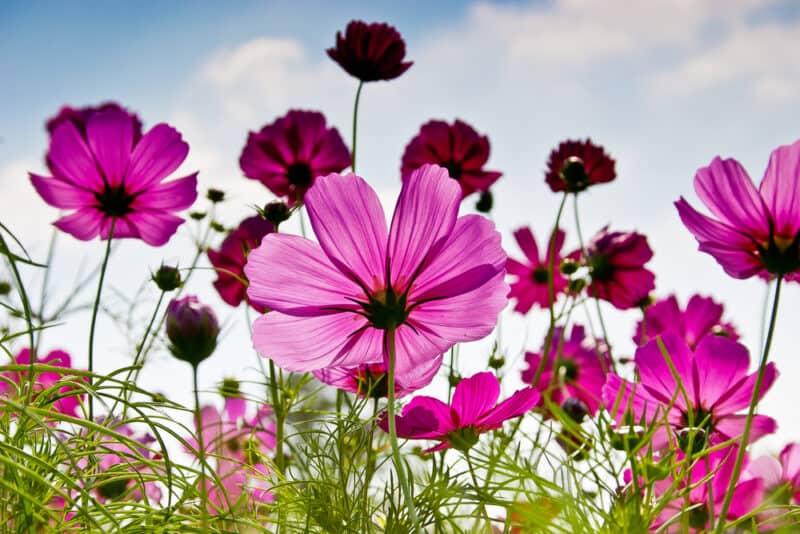
Growing cosmos is easiest if you plant them in full sun, but they can blossom in partial shade. They just won’t be quite as floriferous. Besides light, you’ll also need suitable soil for cosmos.
The ideal soil is well-draining but water retentive. You should aim for a pH level of 6.0-6.8, though cosmos are adaptable.
Cosmos will also grow in dry and depleted soil, but rich soil will result in plants that can’t hold themselves upright.
Taller cosmos, especially those with large flowers, might need some support as they grow. Flower cages or tomatoes cages are just right.
Cosmos do best in hot climates. They aren’t fond of cool climates. Whatever humidity you have is okay because these plants aren’t fussy about humidity levels.
Fertilizer and Water
Fertilizer helps plants bloom, but you must be careful how much fertilizer you feed your growing cosmos. Only apply fertilizer if your soil is deficient. If you need to feed your soil, use a liquid fertilizer that contains whatever your soil is deficient in.
Cosmos don’t need a lot of water unless there are high temperatures and prolonged drought. If you experience a prolonged drought, take a look at your plants now and then. Give them some water if they seem to be drooping in the heat.
Don’t worry, most of the other plants in your garden will need water well before your cosmos do.
Pruning
The primary maintenance for cosmos flowers is occasional deadheading, which ensures your flowers repeatedly bloom until the frost.
You can deadhead your cosmos by cutting the heads off with garden scissors. Cut back to a nearby leaf bud to encourage bushier growth and additional flowers.
Plants grow lots of flowers, so if you want to gather some for arranging, snag the longer stalks and leave the shorter ones behind. You should also leave a few flowers to go to seed so that the plant will reseed itself in the garden.
Common Pests and Diseases
Pests are more common problems for cosmos than diseases.
Aphids
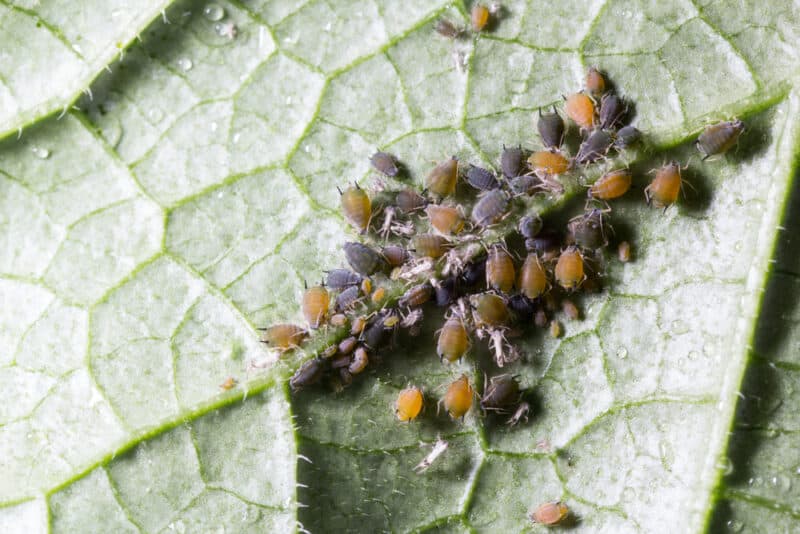
Melon aphids (Aphis gossypii) regularly feed on cosmos, causing yellowing leaves, stunted growth, and spreading disease. Visit our guide to learn about identifying and dealing with aphids.
Earwigs
Earwigs (Forficula auricularia) like to destroy cosmos flowers on some species. You’ll head out to the garden one day and notice ragged edges on the petals. It can be difficult seeing the pests themselves on your plant as they hide during the day and nibble away at night.
Don’t bother with pesticides. These are more of a nuisance than a real pest. You can trap them by placing cardboard on the ground near the plants and picking it up in the morning. Shake off any earwigs you find into soapy water.
Fusarium Wilt
Fusarium wilt is a fungal disease that can attack cosmos. You can spot this disease by the discoloration and wilting of the leaves. The root is the main area affected by this disease, but you can’t see this from looking at your plant.
If you dig up the plant, you’ll see pink masses on the roots.
If your plant is infected, it’s best to pull and dispose of it.
Harvesting Cosmos
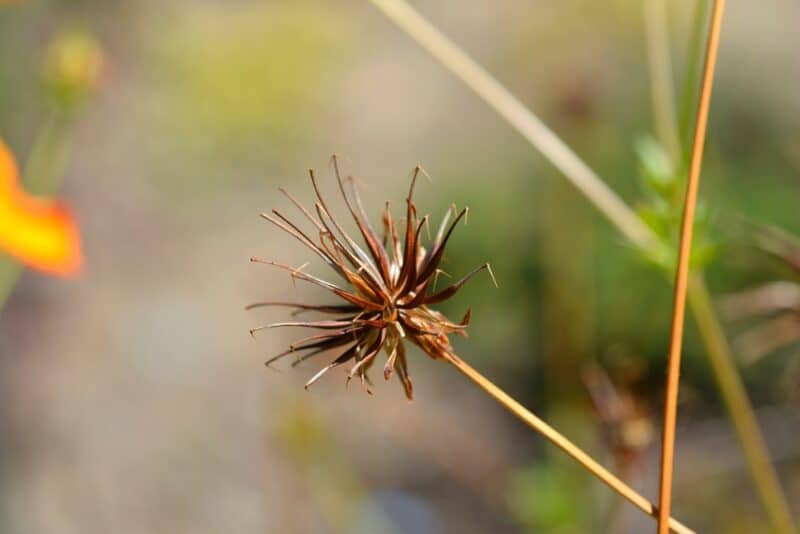
You can harvest both the seeds and the flowers of cosmos plants. The seeds can be collected at the end of the growing season after the flowers have faded and formed seedheads. Or you can pull them from the flowers as they fade individually throughout the growing season.
Normally, the seeds will also spread by the wind and animals, they will disperse around your yard on their own unless you collect them or deadhead the plants.
When you collect the seeds, wait until the weather is dry.
Once the seeds have turned brown, it will be easy to remove the seeds. All you have to do is gently shake the petals, and the seeds will fall off.
If it’s the flowers and not the seeds you’re after, you can cut and harvest the flowers for creating bouquets in your home. Pick the flowers with a long stem if you want to place them in a tall vase. To create a small bouquet, go for the flowers with a short stem.

Avoid picking the flowers at the warmest time of the day, so morning or early evening is an excellent time to harvest.
If you want to save money on buying seeds, growing cosmos is a great way to harvest your own seeds and have a fresh bouquet in your house. Plus, cosmos are ideal plants for beginner gardeners that don’t have a lot of experience with growing flowers.
Remember to deadhead regularly, save the seeds, and plant in well-draining soil, and you’ll have a lovely collection of cosmos plants!
